Related Research Articles
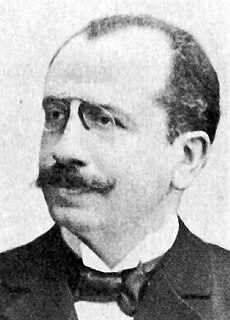
Albert Ballin was a German shipping magnate. He was the general director of the Hamburg-Amerikanische Packetfahrt-Actien-Gesellschaft (HAPAG) or Hamburg-America Line, which for a time was the world's largest shipping company. Being the inventor of the concept of the cruise ship, he is known as the father of modern cruise ship travel.
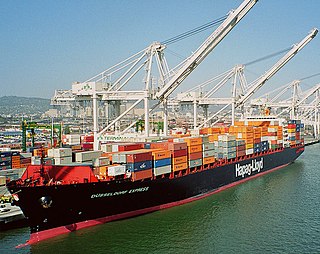
Hapag-Lloyd AG is a German international shipping and container transportation company. Hapag-Lloyd was formed in 1970 through a merger of Hamburg-American Line (HAPAG) and North German Lloyd.
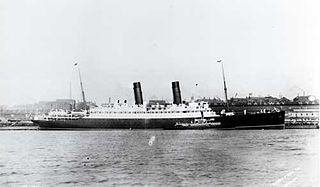
RMS Laconia was a Cunard ocean liner built by Swan Hunter & Wigham Richardson, launched on 27 July 1911, with the wife of the U.S. Ambassador Mrs. Whitelaw Reid christening the vessel. Laconia was delivered to the Cunard Line on 12 December 1911, and began service on 20 January 1912. She was the first Cunard ship of that name. She was torpedoed and sunk on 25 February 1917 during World War I; 12 passengers were killed.

United States Lines was the trade name of an organization of the United States Shipping Board (USSB), Emergency Fleet Corporation (EFC) created to operate German liners seized by the United States in 1917. The ships were owned by the USSB and all finances of the line were controlled by the EFC. Among the notable ships of this period was Leviathan, a contender for largest ship in the world for a time.
Steerage is a term for the lowest category of passenger accommodation in a ship. In the nineteenth and early twentieth century considerable numbers of persons travelled from their homeland to seek a new life elsewhere, in many cases North America and Australia. Many of those people were destitute in their homeland and had the minimum of resources to procure transportation. The term later widened to imply the lowest category of accommodation on a passenger vessel.

The Hamburg-Amerikanische Packetfahrt-Aktien-Gesellschaft (HAPAG), known in English as the Hamburg America Line, was a transatlantic shipping enterprise established in Hamburg, in 1847. Among those involved in its development were prominent citizens such as Albert Ballin, Adolph Godeffroy, Ferdinand Laeisz, Carl Woermann, August Bolten, and others, and its main financial backers were Berenberg Bank and H. J. Merck & Co. It soon developed into the largest German, and at times the world's largest, shipping company, serving the market created by German immigration to the United States and later, immigration from Eastern Europe. On 1 September 1970, after 123 years of independent existence, HAPAG merged with the Bremen-based North German Lloyd to form Hapag-Lloyd AG.

Norddeutscher Lloyd was a German shipping company. It was founded by Hermann Henrich Meier and Eduard Crüsemann in Bremen on 20 February 1857. It developed into one of the most important German shipping companies of the late 19th and early 20th centuries, and was instrumental in the economic development of Bremen and Bremerhaven. On 1 September 1970, the company merged with Hamburg America Line (HAPAG) to form Hapag-Lloyd AG.

The International Mercantile Marine Company, originally the International Navigation Company, was a trust formed in the early twentieth century as an attempt by J.P. Morgan to monopolize the shipping trade.

SS Leviathan was launched on 3 April 1913 and began service in 1914 as the German liner Vaterland (Fatherland) for Germany's Hamburg America Line to be used on its transatlantic passenger service. The ship, second of three running mates and then the largest passenger ship in the world, made its first voyage to New York arriving on 21 May 1914 under the command of a Commodore and four Captains of the German Naval Reserve to celebrations featuring German and American officials at the line's Hoboken facilities. The ship was designed to carry 4,050 passengers with most in third or fourth class. Those among the 700 first class and 600 second class passengers traveled in considerable luxury. The main public rooms took advantage of an unusual arrangement of the routing from boiler to stack along the sides rather than center to feature long and unbroken access from a replica of the New York Ritz-Carlton Restaurant main dining room forward to the lounge and ball room aft. Vaterland served on the route for less than a year before being laid up at the line's piers in the neutral United States due to the start of World War I and risk of seizure by the Allies at sea.

USS DeKalb (ID-3010) was the German mail ship Prinz Eitel Friedrich that served during the early part of the First World War as an auxiliary cruiser (Hilfkreuzer) in the Imperial German Navy and later after the US entry into the war, as a US Navy troop ship. Post war she returned to civilian service as the US transatlantic liner SS Mount Clay.

SS Cleveland was a German transatlantic ocean liner that was launched in 1908 and scrapped in 1933. Cleveland was built for the Hamburg America Line (HAPAG) as a sister ship for Cincinnati.
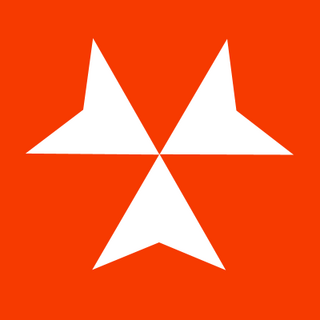
Hamburg Atlantic Line was an ocean liner and cruise ship operating company established in Hamburg, West Germany in 1958 by Axel Bitsch Christensen and Vernicos Eugenides, the latter being the adopted son of Home Lines' founder Eugen Eugenides. In 1966 the company changed its name to German Atlantic Line. Liner services were abandoned in 1969, after which the company's ships concentrated solely on cruising. Due to the 1973 oil crisis, German Atlantic Line closed down in December 1973.

SS Prinz Eitel Friedrich was a German passenger liner which saw service in the First World War as an auxiliary cruiser of the Imperial German Navy. Though largely overlooked, Prinz Eitel Friedrich was, after SS Kronprinz Wilhelm, the most successful of Germany’s first wave of auxiliary cruisers. She was able to remain at large for seven months, from August 1914 to March 1915, and sank 11 ships, for a total tonnage of 33,000 GRT.
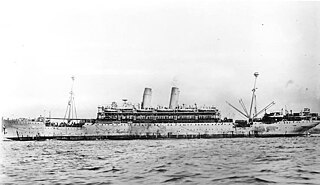
USS Princess Matoika (ID-2290) was a transport ship for the United States Navy during World War I. Before the war, she was a Barbarossa-class ocean liner that sailed as SS Kiautschou for the Hamburg America Line and as SS Princess Alice for North German Lloyd. After her World War I Navy service ended, she served as the United States Army transport ship USAT Princess Matoika. In post-war civilian service she was SS Princess Matoika until 1922, SS President Arthur until 1927, and SS City of Honolulu until she was scrapped in 1933.
The H. Vogemann Group is a German shipping company. Founded in 1886, the company is privately owned by its managing partners and its fleet of bulk carriers has a capacity of more than 1.5 million tonnes deadweight (DWT).
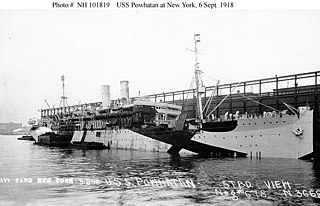
USS Powhatan (ID–3013) was a transport ship for the United States Navy during World War I. She was originally the SS Hamburg, a Barbarossa-class ocean liner built in 1899 by Aktiengesellschaft Vulkan of Stettin, Germany, for the Hamburg America Line. At the outset of World War I the ship was interned by the United States.

Deutsche Ost-Afrika Linie was a shipping line, established in 1890 as an alternative to the existing shipping services to East Africa, including German East Africa (1891–1919), then dominated by United Kingdom shipping lines.
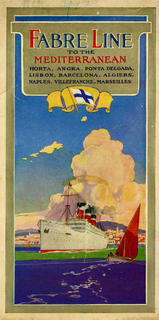
The Fabre Line or Compagnie Francaise de Navigation a Vapeur Cyprien Fabre & Compagnie was a French shipping line formed in 1881 by Cyprian Fabre. It began operating a small fleet of sailing ships in 1865. Its ports of call included New York, NY; Providence, Rhode Island; Boston, MA; Ponta Delgada, Madeira, and Lisbon, Portugal; Piraeus, Salonica, and Athens, Greece; Algiers, Morocco; Beirut, Lebanon; Naples & Palermo, Italy; Alexandria, Egypt; Jaffa and Haifa, Palestine; Constantinople, Turkey; and Monaco and Marseilles, France.
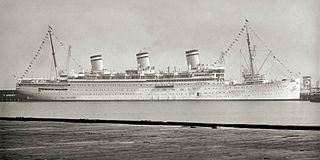
SS Reliance was one of a pair of a pair of transatlantic steam ocean liners that were launched in 1914 in Germany for the Hamburg America Line (HAPAG), sold to a Dutch shipping line in 1916, and seized by the United States as World War I reparations in 1922. United American Lines (UAL) operated her until 1926, when HAPAG bought her back.
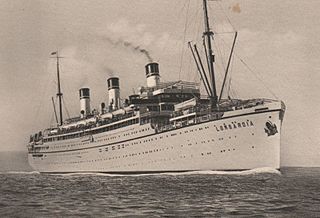
SS Lombardia was one of a pair of a pair of transatlantic steam ocean liners that were launched in 1914 in Germany for the Hamburg America Line (HAPAG), sold to a Dutch shipping line in 1916, and seized by the United States as World War I reparations in 1922. United American Lines (UAL) operated her until 1926, when HAPAG bought her back.
References
- McMillan, Joe (November 29, 2001). "United American Lines (American Shipping and Commercial Corp.)". House Flags of U.S. Shipping Companies. Flags of the World. Retrieved July 3, 2008.
- Swiggum, Susan; Kohli, Marjorie (February 2, 2005). "United American Lines". TheShipsList. Archived from the original on February 10, 2012. Retrieved July 3, 2008.
- "United American Lines (Harriman Line) Passenger Lists 1922-1925". Gjenvick-Gjønvik Archives.